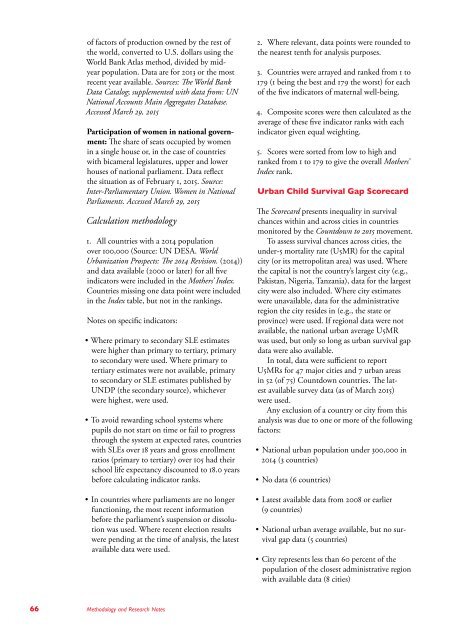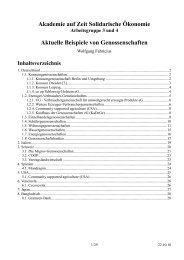sowm_2015__int__africa_full_report_low_res
sowm_2015__int__africa_full_report_low_res
sowm_2015__int__africa_full_report_low_res
Create successful ePaper yourself
Turn your PDF publications into a flip-book with our unique Google optimized e-Paper software.
of factors of production owned by the <strong>res</strong>t of<br />
the world, converted to U.S. dollars using the<br />
World Bank Atlas method, divided by midyear<br />
population. Data are for 2013 or the most<br />
recent year available. Sources: The World Bank<br />
Data Catalog; supplemented with data from: UN<br />
National Accounts Main Aggregates Database.<br />
Accessed March 29, <strong>2015</strong><br />
Participation of women in national government:<br />
The share of seats occupied by women<br />
in a single house or, in the case of countries<br />
with bicameral legislatu<strong>res</strong>, upper and <strong>low</strong>er<br />
houses of national parliament. Data reflect<br />
the situation as of February 1, <strong>2015</strong>. Source:<br />
Inter-Parliamentary Union. Women in National<br />
Parliaments. Accessed March 29, <strong>2015</strong><br />
Calculation methodology<br />
1. All countries with a 2014 population<br />
over 100,000 (Source: UN DESA. World<br />
Urbanization Prospects: The 2014 Revision. (2014))<br />
and data available (2000 or later) for all five<br />
indicators were included in the Mothers’ Index.<br />
Countries missing one data po<strong>int</strong> were included<br />
in the Index table, but not in the rankings.<br />
Notes on specific indicators:<br />
• Where primary to secondary SLE estimates<br />
were higher than primary to tertiary, primary<br />
to secondary were used. Where primary to<br />
tertiary estimates were not available, primary<br />
to secondary or SLE estimates published by<br />
UNDP (the secondary source), whichever<br />
were highest, were used.<br />
• To avoid rewarding school systems where<br />
pupils do not start on time or fail to prog<strong>res</strong>s<br />
through the system at expected rates, countries<br />
with SLEs over 18 years and gross enrollment<br />
ratios (primary to tertiary) over 105 had their<br />
school life expectancy discounted to 18.0 years<br />
before calculating indicator ranks.<br />
• In countries where parliaments are no longer<br />
functioning, the most recent information<br />
before the parliament’s suspension or dissolution<br />
was used. Where recent election <strong>res</strong>ults<br />
were pending at the time of analysis, the latest<br />
available data were used.<br />
2. Where relevant, data po<strong>int</strong>s were rounded to<br />
the nea<strong>res</strong>t tenth for analysis purposes.<br />
3. Countries were arrayed and ranked from 1 to<br />
179 (1 being the best and 179 the worst) for each<br />
of the five indicators of maternal well-being.<br />
4. Composite sco<strong>res</strong> were then calculated as the<br />
average of these five indicator ranks with each<br />
indicator given equal weighting.<br />
5. Sco<strong>res</strong> were sorted from <strong>low</strong> to high and<br />
ranked from 1 to 179 to give the overall Mothers’<br />
Index rank.<br />
Urban Child Survival Gap Scorecard<br />
The Scorecard p<strong>res</strong>ents inequality in survival<br />
chances within and across cities in countries<br />
monitored by the Countdown to <strong>2015</strong> movement.<br />
To assess survival chances across cities, the<br />
under-5 mortality rate (U5MR) for the capital<br />
city (or its metropolitan area) was used. Where<br />
the capital is not the country’s largest city (e.g.,<br />
Pakistan, Nigeria, Tanzania), data for the largest<br />
city were also included. Where city estimates<br />
were unavailable, data for the administrative<br />
region the city <strong>res</strong>ides in (e.g., the state or<br />
province) were used. If regional data were not<br />
available, the national urban average U5MR<br />
was used, but only so long as urban survival gap<br />
data were also available.<br />
In total, data were sufficient to <strong>report</strong><br />
U5MRs for 47 major cities and 7 urban areas<br />
in 52 (of 75) Countdown countries. The latest<br />
available survey data (as of March <strong>2015</strong>)<br />
were used.<br />
Any exclusion of a country or city from this<br />
analysis was due to one or more of the fol<strong>low</strong>ing<br />
factors:<br />
• National urban population under 300,000 in<br />
2014 (3 countries)<br />
• No data (6 countries)<br />
• Latest available data from 2008 or earlier<br />
(9 countries)<br />
• National urban average available, but no survival<br />
gap data (5 countries)<br />
• City rep<strong>res</strong>ents less than 60 percent of the<br />
population of the closest administrative region<br />
with available data (8 cities)<br />
66 Methodology and Research Notes




